Influence of Stress Field and Temperature Field on Residual Stress of 2A14 Aluminum Alloy Based on In Situ SAXS Method
Abstract
1. Introduction
2. Materials and Methods
2.1. Materials
2.2. Characterization of Residual Stress and Experiment Methods
2.2.1. Synchrotron Radiation X-ray Diffraction
2.2.2. Load Stress
2.2.3. Temperature Test
3. Results and Discussion
3.1. Diffraction Information of 2A14 Aluminum Alloy under Stress Field
3.2. Diffraction Information of 2A14 Aluminum Alloy under Temperature Field
3.3. Diffraction Information of 2A14 Aluminum Alloy under the Alternating Action of Thermo-Mechanical Coupling
4. Conclusions
- (1)
- With the continuous increase of the external load, the residual stress of the 2A14 aluminum alloy perpendicular to the tensile direction gradually increases. When the external load is greater than 320 MPa (Yield strength of 2A14 aluminum alloy), the residual stress changes are no longer significant.
- (2)
- Under the action of the temperature, the grains experience expansion, recovery and shrinkage phenomena when 2A14 aluminum alloy undergoes a heating–holding–cooling process; the grain deformation releases a small part of the lattice distortion and reduces a part of the residual stress.
- (3)
- Under the action of thermo-mechanical coupling, the 2A14 aluminum alloy triggers the recovery effect, releases the deformation energy storage, reduces the lattice strain and reduces the residual stress introduced by the external load in the heating–holding–cooling process; moreover, the stress reduction effect at 280 °C is better than that at 200 °C.
Author Contributions
Funding
Institutional Review Board Statement
Informed Consent Statement
Data Availability Statement
Acknowledgments
Conflicts of Interest
References
- Lin, G.Y.; Zhengm, X.Y.; Feng, D.; Yang, W.; Peng, D.S. Research development of quenching-induced residual stress of aluminum thick plates. Mater. Rep. 2008, 22, 70–74. [Google Scholar]
- Li, J.-G.; Wang, S.-Q. Distortion caused by residual stresses in machining aeronautical aluminum alloy parts: Recent advances. Int. J. Adv. Manuf. Technol. 2016, 89, 997–1012. [Google Scholar] [CrossRef]
- Zeng, S.M. New technique of eliminating residual stress in extra-thick aluminum alloy forging. Chin. J. Nonferrous Met. 1996, 3, 67–70. [Google Scholar]
- Liu, S.Z.; Chen, L.J. Analysis of the Cracks Causes for Pre-stretching Plates of 7075 T651 Alloy. Light Alloy. Fabr. Technol. 2000, 28, 18–20. [Google Scholar]
- Hu, S.; Hui, Z.; Yang, L.; Lin, G.Y.; Zhang, Y. Numerical analysis of temperature and thermal stresses fields in quenching 7075 aluminum alloy thick plates. Nat. Sci. J. Xiangtan Univ. 2004, 6, 66–71. [Google Scholar]
- Li, B.Z.; Jiang, X.H.; Yang, J.G.; Liang, S.Y. Effects of depth of cut on the redistribution of residual stress and distortion during the milling of thin-walled part. J. Mater. Process. Technol. 2015, 216, 223–233. [Google Scholar] [CrossRef]
- Singh, A.; Agrawal, A. Investigation of surface residual stress distribution in deformation machining process for aluminum alloy. J. Mater. Process. Technol. 2015, 225, 195–202. [Google Scholar] [CrossRef]
- Gadallah, R.; Tsutsumi, S.; Aoki, Y.; Fujii, H. Investigation of residual stress within linear friction welded steel sheets by alternating pressure via X-ray diffraction and contour method approaches. J. Manuf. Process. 2021, 64, 1223–1234. [Google Scholar] [CrossRef]
- Yuan, S.X.; Fei, Y.; Fan, K.C.; Gong, Y.D. Measurement of the residual stress distribution in a thick pre-stretched aluminum plate. In Proceedings of the International Symposium on Precision Mechanical Measurements; International Society for Optics and Photonics: Bellingham, WA, USA, 2008; p. 71302D. [Google Scholar]
- Hu, Y.H.; Wu, Y.X.; Wang, G.Y.; Guo, J.K. Surface Yield Strength Gradient versus Residual Stress Relaxation of 7075 Aluminum Alloy. Adv. Mater. Res. 2010, 160–162, 241–246. [Google Scholar] [CrossRef]
- Robinson, J.S.; Tanner, D.A. Reducing Residual Stress in 7050 Aluminum Alloy Die Forgings by Heat Treatment. J. Eng. Mater. Technol. 2008, 130, 635–644. [Google Scholar] [CrossRef]
- Ferreira-Barragáns, S.; Fernández, R.; Fernández-Castrillo, P.; Gonzalez-Doncel, G. Kinetics of tri-axial and spatial residual stress relaxation: Study by synchrotron radiation diffraction in a 2014Al alloy. J. Alloys Compd. 2012, 523, 94–101. [Google Scholar] [CrossRef][Green Version]
- Croucher, T. Minimizing Machining Distortion in Aluminum Alloys through Successful Application of Uphill Quenching-A Process Overview. J. ASTM Int. 2009, 6, 1–14. [Google Scholar]
- Wang, Q.C.; Ke, Y.L.; Xing, H.Y.; Weng, Z.; Yang, F. Evaluation of residual stress relief of aluminum alloy 7050 by using crack compliance method. Trans. Nonferrous Met. Soc. China 2003, 13, 1190–1193. [Google Scholar]
- Robinson, J.S.; Hossain, S.; Truman, C.E.; Paradowska, A.M.; Hughes, D.J.; Wimpory, R.C.; Fox, M.E. Residual stress in 7449 aluminum alloy forgings. Mater. Sci. Eng. A 2010, 527, 2603–2612. [Google Scholar] [CrossRef]
- Prime, M.B.; Hill, M.R. Residual stress, stress relief, and inhomogeneity in aluminum plate. Scr. Mater. 2002, 46, 77–82. [Google Scholar] [CrossRef]
- Liao, K.; Wu, Y.X.; Gong, H.; Yan, P.F.; Guo, J.K. Effect of non-uniform stress characteristics on stress measurement in specimen. Trans. Nonferrous Met. Soc. China 2010, 20, 789–794. [Google Scholar] [CrossRef]
- Zhu, C.C. Numerical Simulation and Experimental Investigation of the Aluminium Alloy Quenching Process by Considering the Flow Stress Characteristic. J. Mech. Eng. 2011, 47, 57–62. [Google Scholar] [CrossRef]
- Li, R.G.; Xie, Q.G.; Wang, Y.D.; Wu, G.; Li, X.; Zhang, M.; Lu, Z.; Geng, C.; Zhu, T. Unraveling submicron-scale mechanical heterogeneity by three-dimensional X-ray microdiffraction. Proc. Natl. Acad. Sci. USA 2018, 115, 483–488. [Google Scholar] [CrossRef]
- Withers, P.J. Residual stress and its role in failure. Rep. Prog. Phys. 2007, 70, 2211–2264. [Google Scholar] [CrossRef]
- Sinha, V.K.; Godaba, V.S. Residual stress measurement in worked and heat treated steel by X-ray diffractometry. Mater. Sci. Eng. A 2008, 488, 491–495. [Google Scholar] [CrossRef]
- Hughes, D.J.; Chen, Z. High resolution near-surface stress determination using synchrotron X-rays. Nucl. Instrum. Methods Phys. Res. Sect. B Beam Interact. Mater. At. 2005, 238, 214–218. [Google Scholar] [CrossRef]
- Webster, P.J.; Oosterkamp, L.D.; Browne, P.A.; Hughes, D.J.; Kang, W.P.; Withers, P.J.; Vaughan, G.M. Synchrotron X-ray residual strain scanning of a friction stir weld. J. Strain Anal. Eng. Des. 2001, 36, 61–70. [Google Scholar] [CrossRef]
- Okoro, C.; Levine, L.E.; Xu, R.; Hummler, K.; Obeng, Y.S. Nondestructive Measurement of the Residual Stresses in Copper Through-Silicon Vias Using Synchrotron-Based Microbeam X-Ray Diffraction. IEEE Trans. Electron Devices 2014, 61, 2473–2479. [Google Scholar] [CrossRef]
- Beaudoin, A.J.; Obstalecki, M.; Tayon, W.; Hernquist, M.; Mudrock, R.; Kenesei, P.; Lienert, U. In situ assessment of lattice strain in an Al–Li alloy. Acta Mater. 2013, 61, 3456–3464. [Google Scholar] [CrossRef]
- Beaudoin, A.J.; Obstalecki, M.; Storer, R.; Tayon, W.; Mach, J.; Kenesei, P.; Lienert, U. Validation of a crystal plasticity model using high energy diffraction microscopy. Model. Simul. Mater. Sci. Eng. 2012, 20, 24006. [Google Scholar] [CrossRef]
- Li, Z.Y.; Xue, B.; Cui, Y.; Zhou, G.; Zhang, S.; Lu, N.; Wen, L.; Zhang, D. NDT of Residual Stress in Thick Aluminum Alloy Plates under Different Aging Conditions Using Multiple Techniques. Materials 2022, 15, 8732. [Google Scholar] [CrossRef]
- Pope, C.G. X-ray diffraction and the Bragg equation. J. Chem. Educ. 1997, 74, 129. [Google Scholar] [CrossRef]
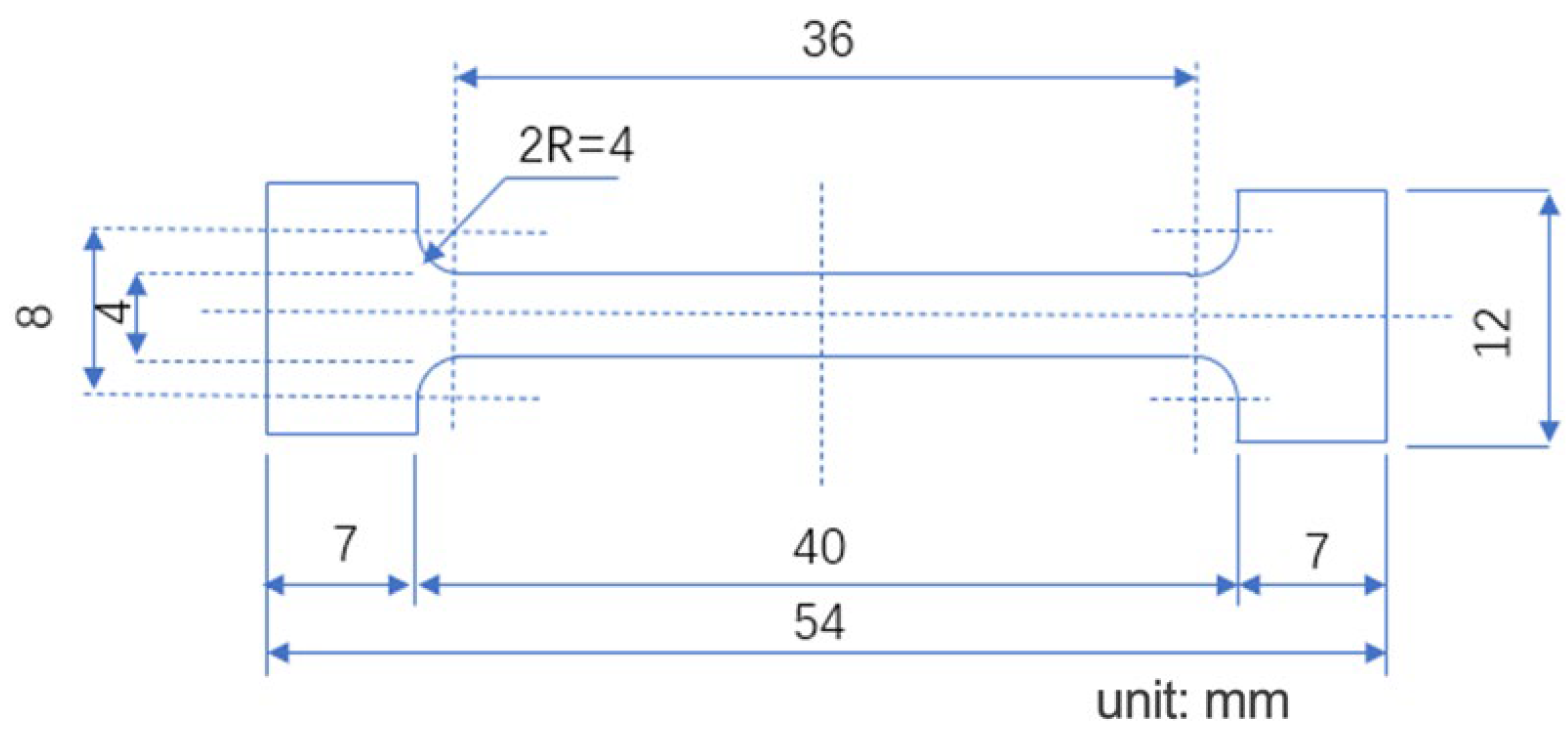
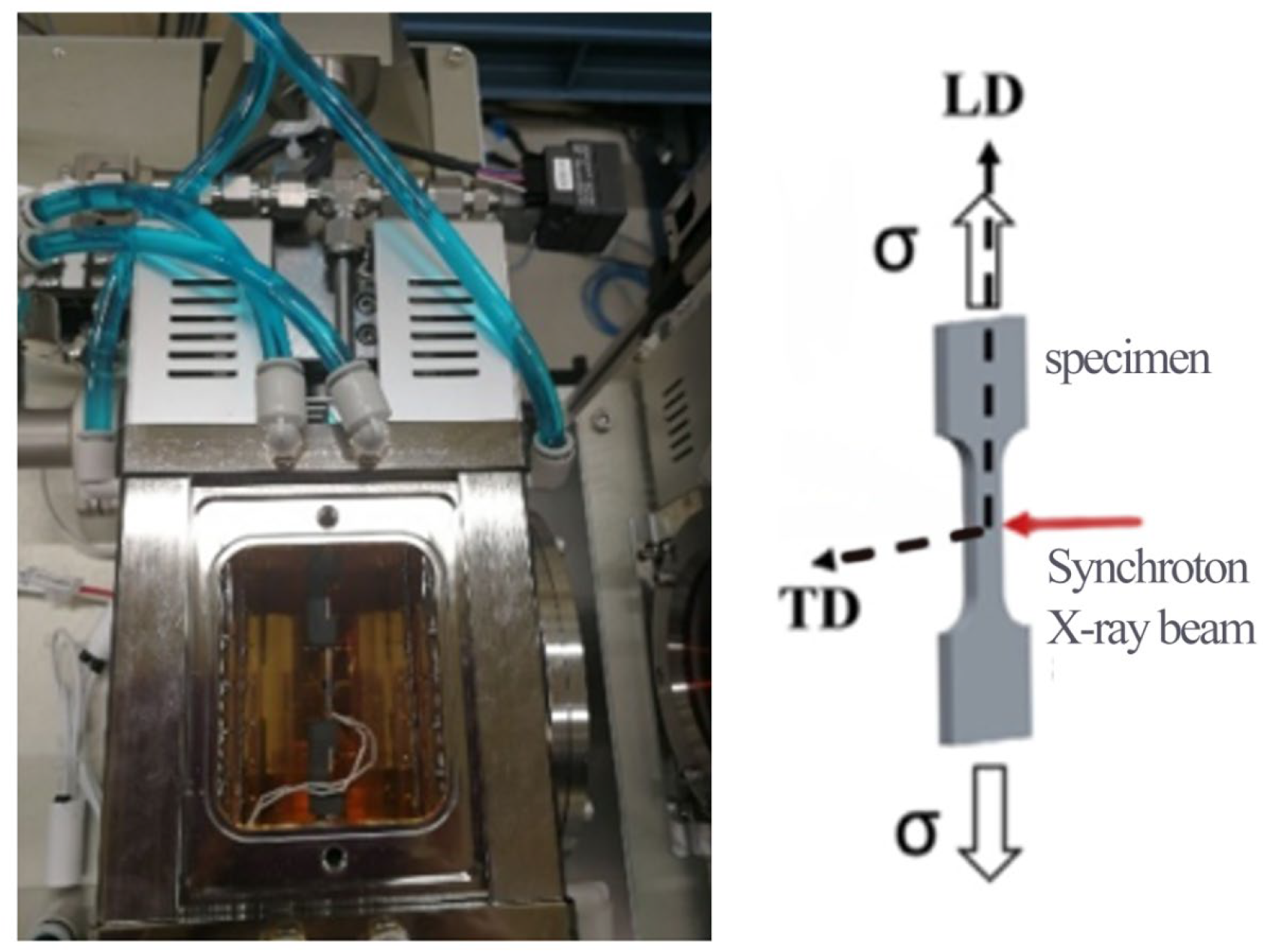

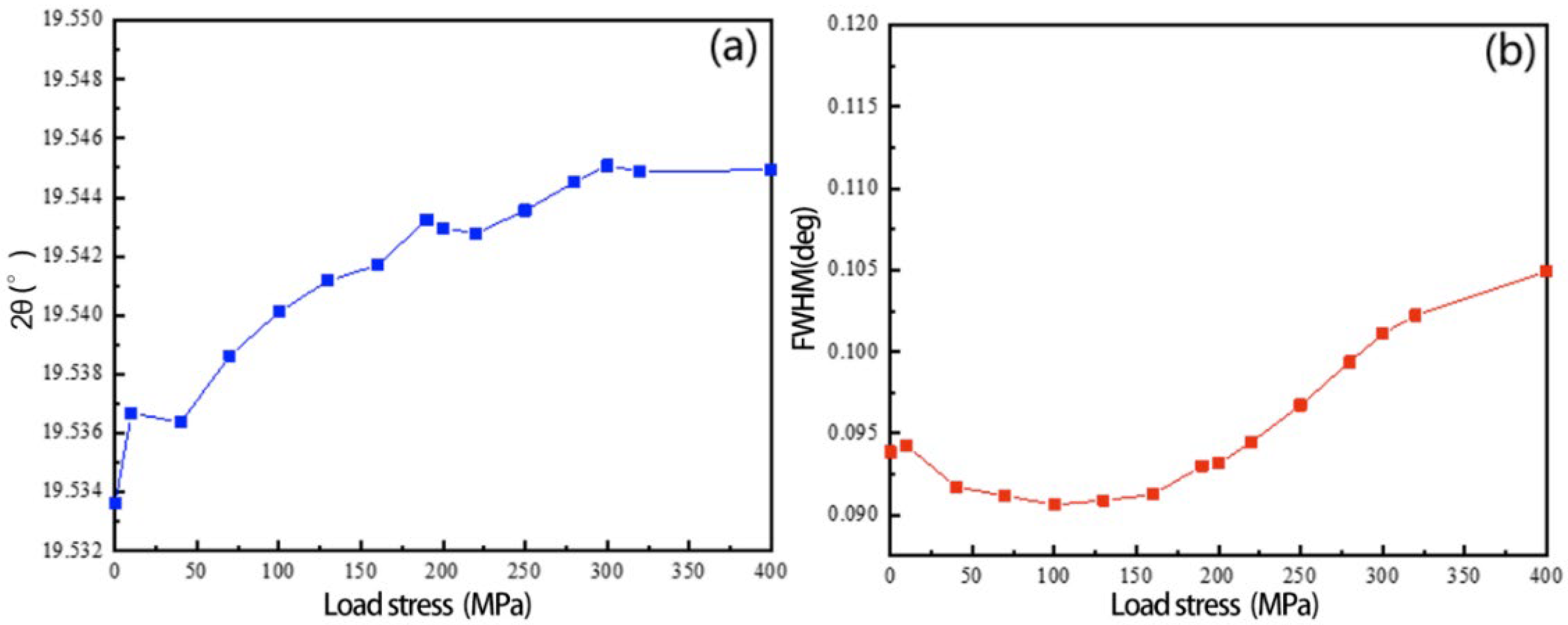

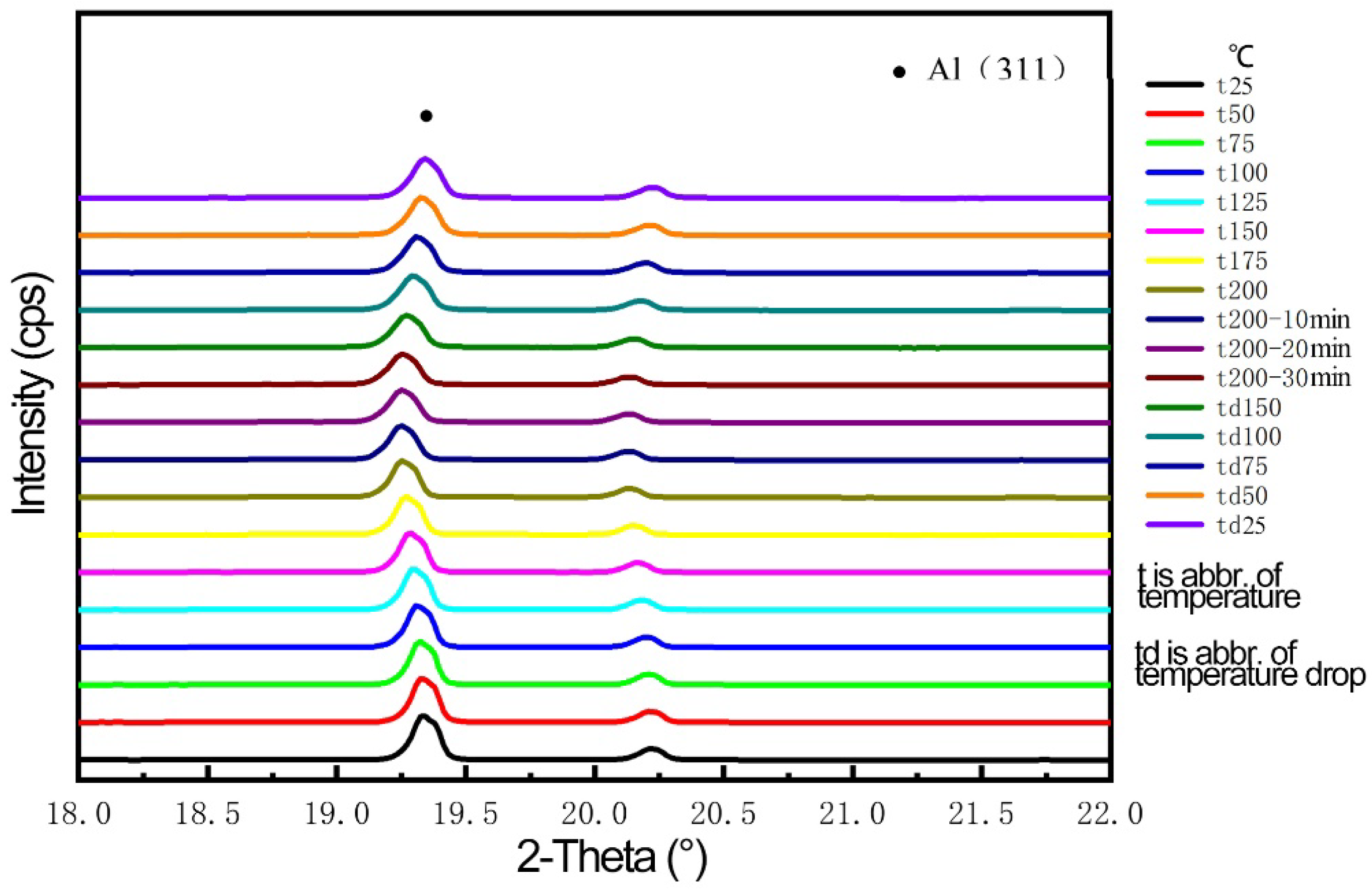
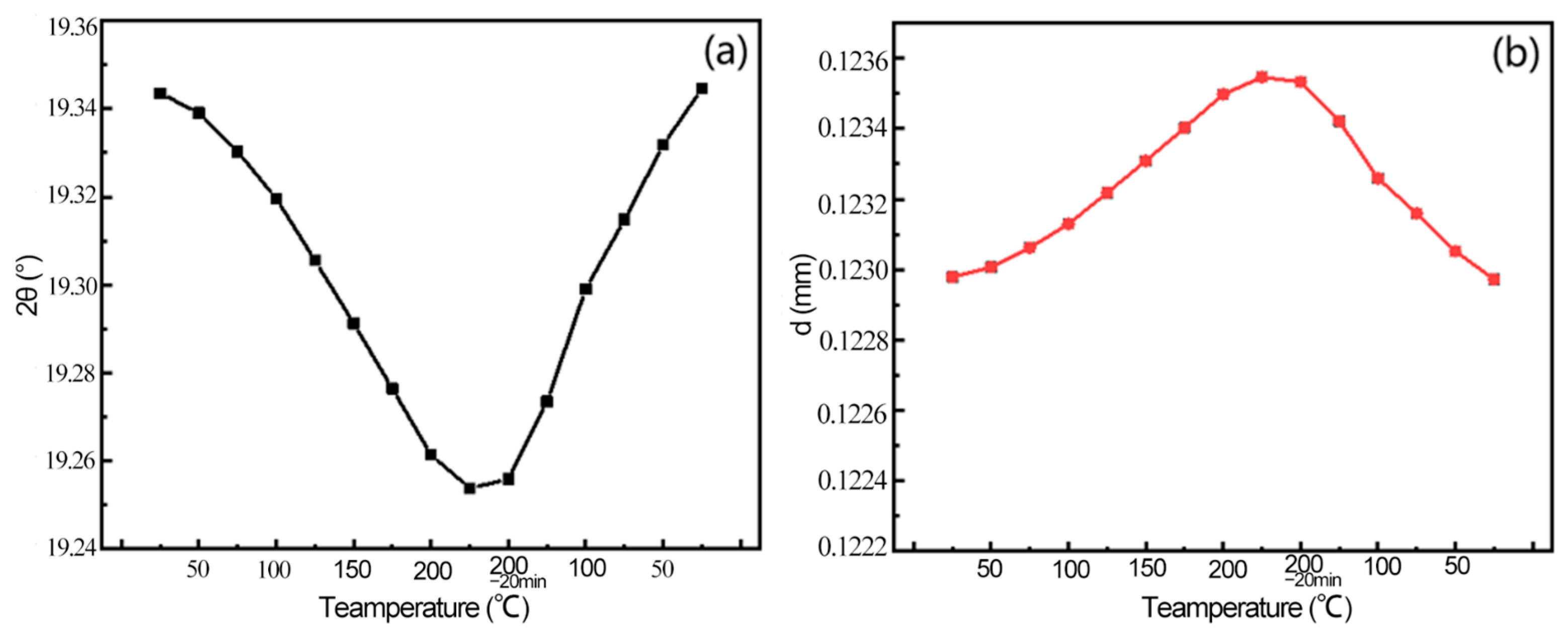
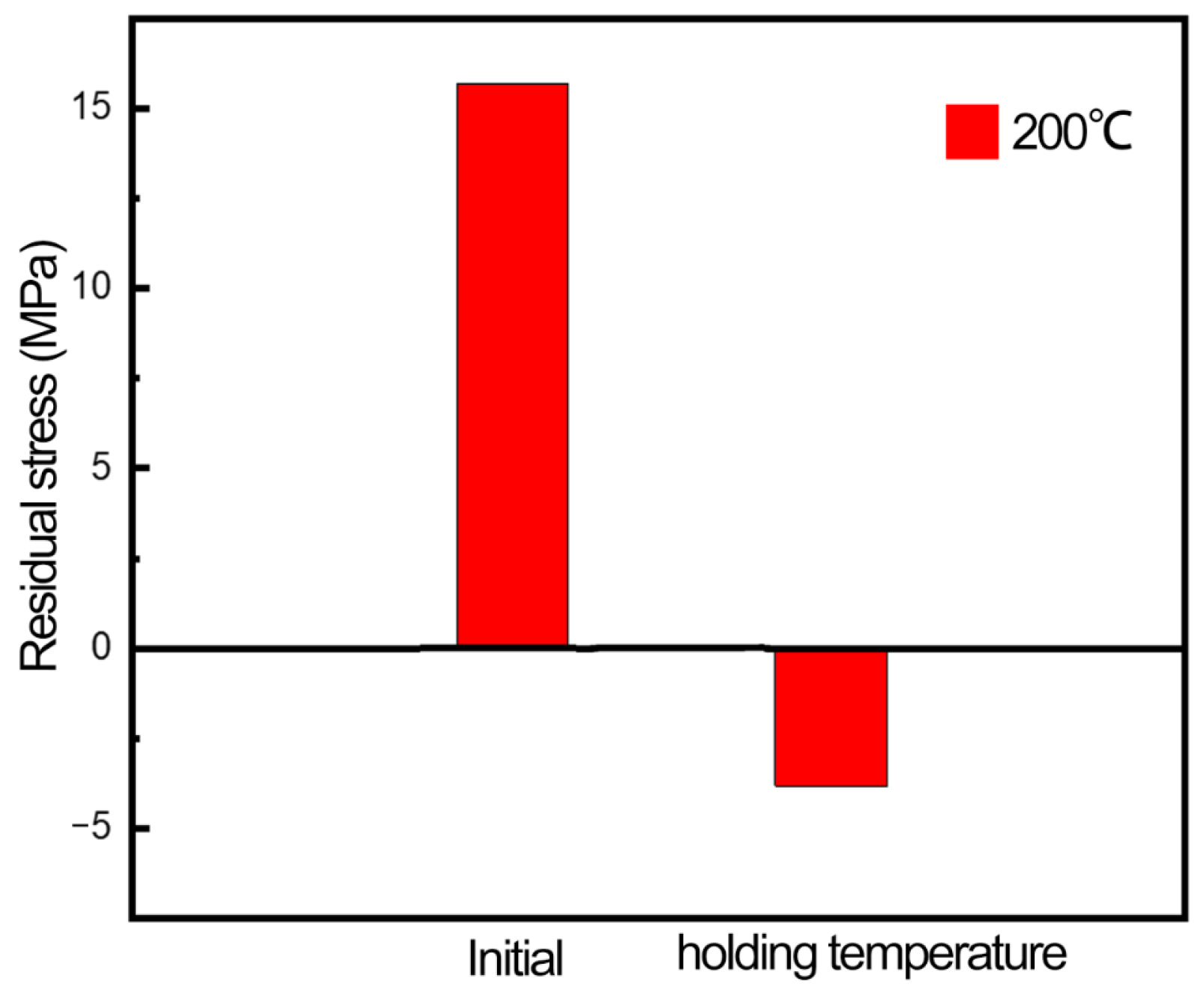
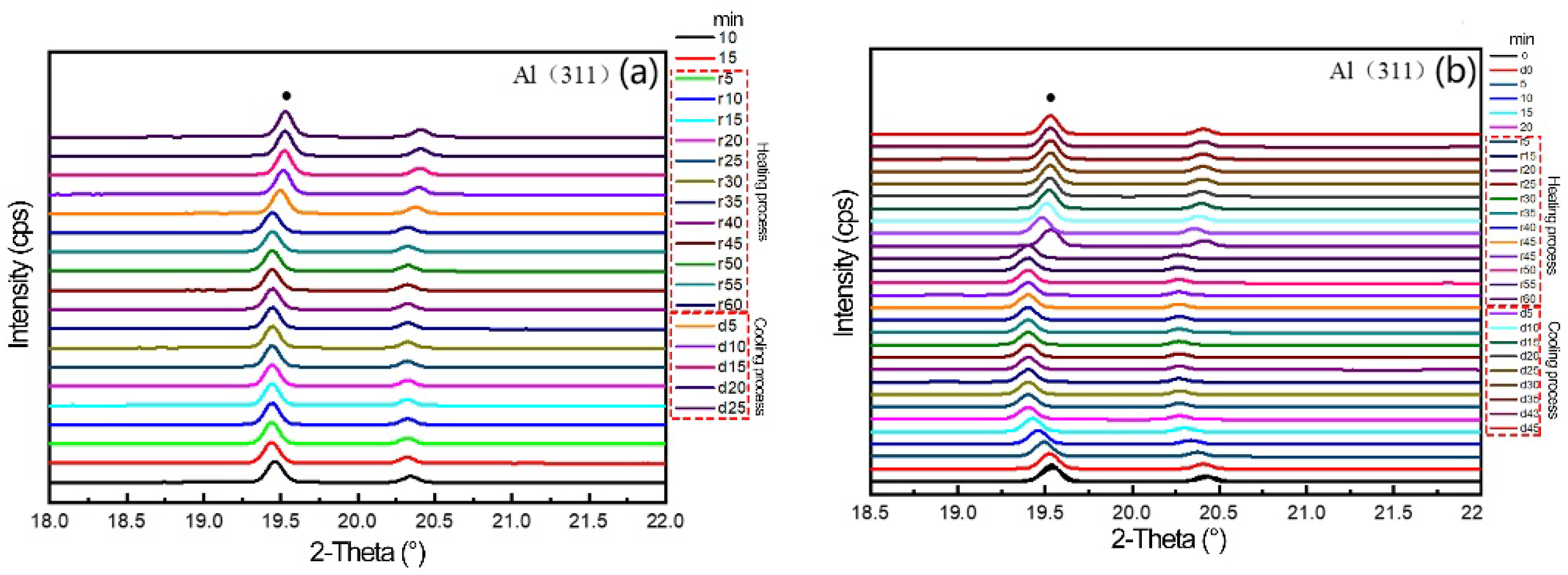
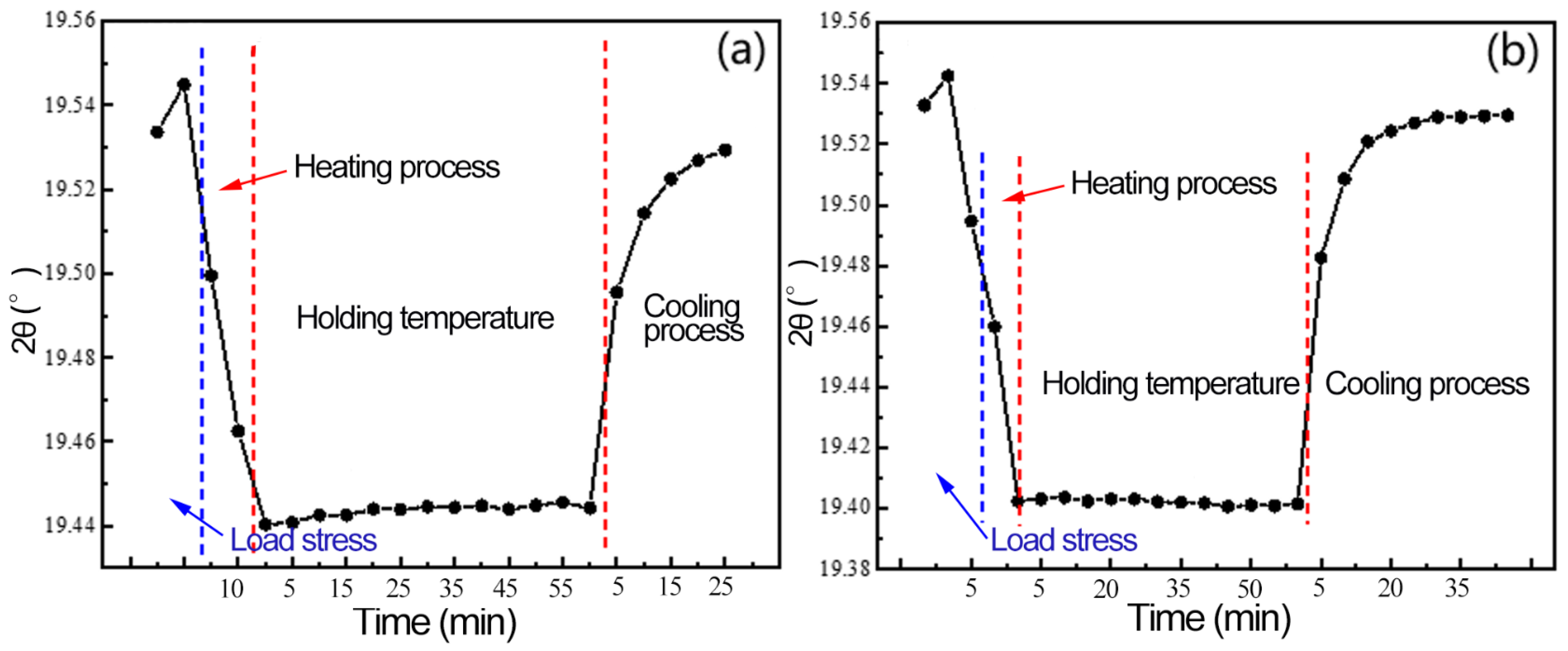
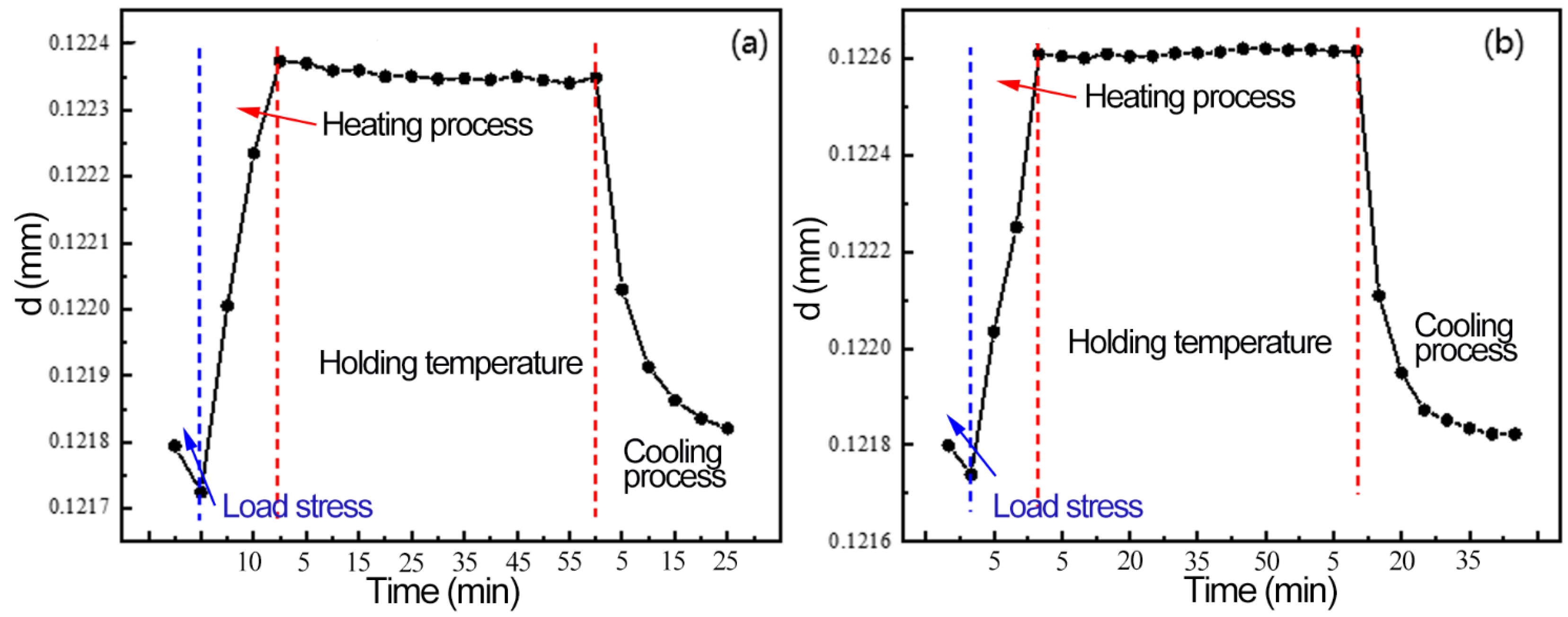

| Cu | Mg | Mn | Si | Fe | Zn | Al |
|---|---|---|---|---|---|---|
| 4.32 | 0.64 | 0.84 | 0.85 | 0.29 | 0.08 | Bal. |
Disclaimer/Publisher’s Note: The statements, opinions and data contained in all publications are solely those of the individual author(s) and contributor(s) and not of MDPI and/or the editor(s). MDPI and/or the editor(s) disclaim responsibility for any injury to people or property resulting from any ideas, methods, instructions or products referred to in the content. |
© 2022 by the authors. Licensee MDPI, Basel, Switzerland. This article is an open access article distributed under the terms and conditions of the Creative Commons Attribution (CC BY) license (https://creativecommons.org/licenses/by/4.0/).
Share and Cite
Yang, G.; Xue, B.; Li, Z.; Zhou, G.; Zhang, S.; Lu, N.; Wen, L.; Zhang, D. Influence of Stress Field and Temperature Field on Residual Stress of 2A14 Aluminum Alloy Based on In Situ SAXS Method. Materials 2023, 16, 170. https://doi.org/10.3390/ma16010170
Yang G, Xue B, Li Z, Zhou G, Zhang S, Lu N, Wen L, Zhang D. Influence of Stress Field and Temperature Field on Residual Stress of 2A14 Aluminum Alloy Based on In Situ SAXS Method. Materials. 2023; 16(1):170. https://doi.org/10.3390/ma16010170
Chicago/Turabian StyleYang, Guanghui, Bing Xue, Zhengyi Li, Gang Zhou, Shaohua Zhang, Ning Lu, Lei Wen, and Duzhou Zhang. 2023. "Influence of Stress Field and Temperature Field on Residual Stress of 2A14 Aluminum Alloy Based on In Situ SAXS Method" Materials 16, no. 1: 170. https://doi.org/10.3390/ma16010170
APA StyleYang, G., Xue, B., Li, Z., Zhou, G., Zhang, S., Lu, N., Wen, L., & Zhang, D. (2023). Influence of Stress Field and Temperature Field on Residual Stress of 2A14 Aluminum Alloy Based on In Situ SAXS Method. Materials, 16(1), 170. https://doi.org/10.3390/ma16010170






